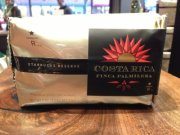
 Tonight (November 26, 2012) I went to a very special coffee seminar event at the Olive Way Starbucks. Coffee masters from the Starbucks headquarters hosted a tasting for the newest Reserve offering, Costa Rica Finca Palmilera, a Geisha coffee. Leslie Wolford (who is a “green coffee specialist” and sources coffee for the stores), and together with Chris Smith (who is on the Coffee Education Team), put on this great event. Both work at the Starbucks headquarters. I can’t even begin to say enough good things about the wealth of knowledge those two partners have about coffee, and if you ever get the chance to meet them, you should. I hope someday to write a feature article about Leslie and Chris. I should say that I learned an enormous amount of new information tonight. I didn’t know about Geisha coffees before the launch of this Reserve offering.
Tonight (November 26, 2012) I went to a very special coffee seminar event at the Olive Way Starbucks. Coffee masters from the Starbucks headquarters hosted a tasting for the newest Reserve offering, Costa Rica Finca Palmilera, a Geisha coffee. Leslie Wolford (who is a “green coffee specialist” and sources coffee for the stores), and together with Chris Smith (who is on the Coffee Education Team), put on this great event. Both work at the Starbucks headquarters. I can’t even begin to say enough good things about the wealth of knowledge those two partners have about coffee, and if you ever get the chance to meet them, you should. I hope someday to write a feature article about Leslie and Chris. I should say that I learned an enormous amount of new information tonight. I didn’t know about Geisha coffees before the launch of this Reserve offering.
Before I go any further, I must explain what a “Geisha” coffee is. Any coffee which is labeled as a Geisha coffee is considered an “heirloom varietal.” This means that their seed stock is very pure, and has not been hybridized or altered. In fact, the original source of this coffee varietal traces back to the city of Gesha, in southwestern Ethiopia. “Geisha” with an “i” is an alternate spelling for this coffee, and the one that has been adopted by Latin American farms growing Geisha varietal coffee trees. As I understand it, farmers in Costa Rica imported the seeds in the 1950s. Farmers in Panama bought the seed stock in the 1960s, having heard that the Geisha coffee trees were more resistant to fungal infestation than other varietals of coffee. However, this varietal only grows at high elevations (about 3,000 feet or higher), and is very low-yielding. This means that a Geisha varietal produces far fewer coffee cherries than a typical coffee tree. Each cherry has a lot more flavor than the usual coffee cherry. The trees’ low yield allows for more of the soil’s nutrients to reach each cherry, intensifying the coffee’s vibrant flavors.
Many farmers found sourcing this coffee too difficult, and it didn’t spread wildly as a popular coffee variety. In fact, most farmers who attempted to grow this quickly gave up and abandoned it in favor of traditional coffee cherry varietals producing many more cherries on a tree.
As I understand it from the Starbucks coffee masters tonight, in 2011, a record was set when farmers in the western part of Panama sold (at auction) one-pound bags of green Geisha coffee beans for around $170.00. A few farmers elsewhere became interested in this unique Geisha seed stock.
Starbucks has long had a close relationship with the family-owned La Candililla estate in Costa Rica. In 2005, Starbucks chose a coffee from the La Candililla estate as a Black Apron offering. (“Black Apron” coffees were the predecessors to the current Reserve coffee platform). At some point in the 2000s, two of the brothers (family owners) of this La Candililla estate began to grow Geisha varietal coffee trees. Marvin and Didier Sanchez set aside just three hectares of their estate to grow Geisha coffee. Starbucks worked collaboratively with these farmers to source a Geisha coffee. Starbucks had been looking to source this rare coffee, and found a great source of it on the La Candililla estate.
This year, Starbucks discovered a perfect crop produced by the La Candililla estate. Sourced from just three hectares out of the 90 hectare estate, Starbucks purchased all of the Geisha coffee offered by the Sanchez family. This amounted to only about 700 large burlap bags of coffee, which was roughly 3,800 pounds of green coffee. I should point out that this is indeed an extremely small coffee acquisition, and not enough to provide very many stores with it. The acquisition of coffee was so tiny that it was roasted not at the very large roasting plant in Kent, Washington, rather it was actually roasted in small batches at the Starbucks headquarters at 2401 Utah Avenue South.
The Reserve Costa Rica Finca Palmilera Geisha varietal coffee is being sold at just 46 Clover Starbucks stores (all in the Pacific Northwest), and offered at $40.00 for a half pound. A customer can order a “tall” size Clover-brewed cup of this coffee for $6.00. It is $7.00 for a Grande size cup of coffee.
At tonight’s coffee seminar we tried this coffee by two brew methods 1) Clover brew method and the 2) Pour Over brew method. About 30 people came to tonight’s coffee tasting. There wasn’t enough room, and some people stood in the aisles to listen to and participate in tonight’s event.
By the way, there was no food pairing for this evening. Starbucks corporate coffee masters do not recommend pairing this coffee with food. You are expected to “enjoy the coffee.” 😉
CLOVER BREWED:
Olive Way Starbucks Coffee Master Jess gave a helping hand and passed out the sample cups of coffee:
By the way, one thing I love about coffee tastings is all the spontaneous conversations that can be heard around you. As the tasting was just getting started with the Clover brewed Costa Rica Finca Palmilera, and people were beginning to smell, slurp, and experience the coffee, I heard a person behind me blurt out, “I totally tasted pineapple in that.” I thought it was a great quote. You may get some pineapple notes in this coffee.
It’s a soft juicy coffee. The Clover brew method of making coffee produces a a little more heavy and textured coffee due to the full immersion technique of the Clover brewer. The coffee had a little sparkle to it, and had soft, sweeter tropical notes as the primary flavor, and then a complex, lush herbal flavor as the coffee cooled. This is also a good coffee to compare at a few different temperatures to see the difference in its flavor.
POUR OVER:
Starbucks corporate coffee masters Leslie and Chris continued to teach us a wealth of information about the sourcing of this coffee:
Chris got the pour overs ready:
The pour over brew method brought the softer fruit notes of this coffee to life. If one were to think about food pairings, natural complementary flavors would be mango, papaya, and white peach. It’s very hard to describe the soft texture of this coffee. I felt like I was drinking a powdered coffee peach. Again, as it cools, the herbal and darker notes of the coffee come to life.
This, by the way, wasn’t my first cup of this coffee. It officially launched on Tuesday, November 20, 2012, and I had my first cup at Olive Way on Thanksgiving.
The treatment of the coffee bean is definitely a lighter roast than what many Starbucks enthusiasts might be used to seeing. The roast profile is designed to feature lots of origin flavors and with almost no roasty-ness as a flavor.
The bottom line is that if you get the chance to try this coffee, don’t pass it up. It won me over. And I will say, that these are the kind of Starbucks experiences that keep me hooked. It was an incredible night of coffee education.
Here are just a few more photos:
My apologies for typos. I really did return home from the coffee seminar, and in an attempt to quickly produce this article, it was written in one fell swoop.
Now it’s your chance to weigh in. I’d be curious if you are already drinking Geisha varietal coffee at home. In the group of 30 people who attended this seminar, not a single person raised their hands when asked about previous experience with this rare coffee.
If you enjoy reading about coffee seminars and tastings, please browse the coffee tastings category on this site for more articles.
Correction on November 28, 2012: 46 Starbucks-branded stores in the Seattle and Portland areas are offering this coffee. One licensed location in Idaho offers this coffee, as well as one non-branded store (Roy Street Coffee and Tea, operated by Starbucks).
Related posts
35 Comments
Leave a Reply Cancel reply
You must be logged in to post a comment.
Sponsors
Recent Comments
- DEVIN on Compostable Straws Land in Seattle Starbucks Stores
- coffeebeanz on Why do you go to Starbucks less often? (If that’s true for you)
- Willi on You can now buy a Siren statue: $6,000
- Willi on A major revamp of your drink recipe: Testing syrup extracts and cane sugar
- Skip on Why do you go to Starbucks less often? (If that’s true for you)



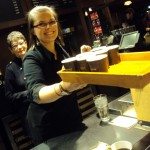

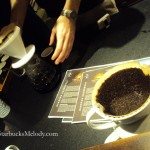
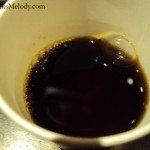
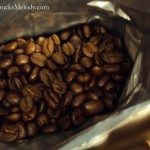
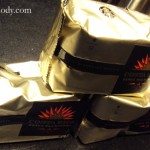
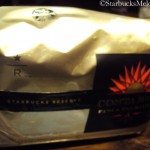



Melody; I have tried more than one geisha coffee so far. They have both been a treat. Thank you very much for the post and especially for the details on the roasting. I was so very worried they would roast this at their usual levels. It is good to see a proper roast for this bean. My experience is that tasting it at several temperature levels is very useful. Sometimes it is hard to just wait between sips though. 🙂
Thank you so much for the information!! I have never tried a geisha coffee…but reading it was fascinating! I’ll put that on my coffee bucket list! 🙂
When I started reading this thread, I was wondering why I hadn’t seen this introduced with the latest new Reserves. I started to think “Hmmmm…. Maybe???” After reading the whole thread, now I’m bummed thinking more like, “Darn and Oh well!” What a tease this thread was. I will just have to enjoy the Ethiopia Sun Dried Sidamo that came out recently instead. For now…..
They really have to take these coffee tastings on the road! Your review of it makes it so enticing and maybe Chris and Leslie should take it on the road to other SB stores. I would be curious how the sales go for this coffee.
When I first heard about this coffee a month or so ago, I traveled to my local Clover location (Streets) to try it out but they didn’t have it. It wasn’t until later I learned it was only available in the PacNW. Strangely, I received an email from Starbucks about this coffee. Included in the email was the fact it was only available in such a small number of PacNW stores. I’m not sure I agree with sending an email promoting a coffee unavailable in my area – unless they pulled my usage information from my card and saw I have been to Seattle a number of times.
I’m glad you enjoyed this Melody and thanks for sharing!
green w/2 jealous! 😉
@Chgo and CD –
The online offering wasn’t this coffee. I actually did not know that until yesterday. I still have the email from StarbucksStore.com, and the online Geisha had the same packaging but did not say on it “Finca Palmilera” but just said “Geisha” – Starbucks had found another farm with a Geisha coffee, and bought it up and set it aside to be able to offer it online. The fully washed Geisha from the Sanchez family farm is the store version. The online version was a semi-washed Geisha from a different Costa Rica farm. They offered it online and the demand was so enormous, that StarbucksStore.com sold out within 24 hours of the offering of it.
I have thought that I might be willing to send some of this coffee to a few regulars who really want to try it, but because of the cost, I’d ask for a $40 Starbucks card to be sent to me or something like that. I think the PNW will be sold out fast, so I’d have to plan quickly.
I’ll be on the lookout for this.
I’ve had a Geisha myself, from Panama, at Stumptown in Manhattan. Guess how much it cost.
.
.
.
.
.
.
.
.
.
.
$20
http://blog.seattlepi.com/thebigblog/2012/11/26/starbucks-new-super-expensive-coffee-worth-it/
I want to know if there is any way to know what Starbucks stores were going to sale this coffee??.. Anyone know???
@Melody – I don’t believe I ever knew about the online offering or this. I’m also not even sure if I ever received an email like CD had received. I guess I don’t read every email Starbucks sends me. I usually scan thru them when they come on my phone. I don’t give them as much attention as I probably should. Maybe I just missed it.
This thread is where I first learned of it. I’m still bummed considering I like the Reserves and look forward to trying all the ones I have never had before. You are so lucky to be able to experience the Reserves that are limited and unavailable to the rest of us. I was wondering why I have not been able to find the Ethiopia Sun Dried Sidamo online at starbucks.com. I’m also wondering if this is in somewhat of a limited supply? I haven’t seen too many bags of it at the Clover Store displayed, but I’m not sure if that is due to limited space because of all the Holiday items. I really like the ESDS, especially iced.
Chris is awesome. I go to go on an origin trip to Costa Rica with him. He leads all the trips around the world…Talk about dream job.
I just checked and I still had the email. It does say Finca Palmilera. The email I received doesn’t say anything about the Starbucks Store though (I never received one of those). This one simply stated it was a rare opportunity to try this and it was only available in the 48 PacNW stores. The top line on the email (not the subject) reads “Enjoy it at your local Clover(r) brewed store.” Given my “local” Clover store is more than 1,000 miles away from the 48 stores brewing it, the email was a bit of a downer. I’m assuming, as I think I mentioned above, they simply pulled my name from their data as I have purchased multiple Clover beverages in Seattle since registering for My Starbucks Rewards in mid-2010.
I’ll forward you the email Melody.
@ CD – I have heard many stories of Starbucks sending emails to people way outside of the geography of where an item is to be found. There was a tiny test in Northern California this summer of a different smoothie (yogurt based, no banana), and I remember in the comments, several people said they got an email to try the new smoothie and they were no where near the one little town with the test smoothie.
There was definitely an email for a Geisha that was not the Finca Palmilera – I have it and might be able to send it to you. I actually didn’t get the email you’re describing but obviously, it should have only been sent to those in the PNW!
CD – This is the coffee that was featured in the email – Notice the packaging just says “Geisha” without naming the farm –
http://www.starbucksstore.com/starbucks-reserve-costa-rica-tarrazu-geisha/011024375,default,pd.html?start=1&cgid=coffee#
Starbucks did not have enough Geisha for one lot to cover both the 46 stores, and the online demand, so they really were two different Geisha coffees!
Oh my giddiness of thinking about this coffee. This is the most intriguing , of all coffees I have ever seen u do. Way to go melody! The excitement you have is incredible. If only we could get some in Boston!!!! Thank you!
Brandi bender
Is there any word on this coffee making its way to any stores in Chicago?
@Jessica – Starbucks has said that they’re actively trying to source more of this coffee varietal. It wouldn’t surprise me if we do see a Geisha with more of a national launch at some point. Welcome to the blog! And that’s a great question. I don’t have the official answer but I’ve given you my best educated guess.
@Brandi – Welcome to the blog! Are you the Brandi that I met earlier this year at the “The Garage” Starbucks in Cambridge, MA? Thanks for being a regular reader!
Earlier in the comments, I mentioned buying a half pound and sending it here and there. Of course, I can’t do this free. And I have to do some planning around this, but if you’re interested, email me at Melody at StarbucksMelody dot com
Thank you Melody 🙂
It sure would be great to at least have one cup of it.
I’m emailing you now, about the idea of sending some of it.
@Melody – It’s great to see you were quoted in the Shine section of Yahoo today about the Geisha.
shine.yahoo.com/shine-food/starbucks-most-expensive-cup-coffee-ever-worth-185800479.html
@Chgo – great find! I notice Jim at SG is linking to that article now…but no shout out or kudos to Melody…
Single varietals are always great! (wine, tea, coffee…)
And, so WHERE are these 46 stores??? How is it the most important part gets left out?
@MrBadabing – I wrote “all in the Pacific Northwest” – That is still a true statement. If you happen to be near a Reserve Clover store in WA or Oregon, use the store locator to find one near you.
@AmazonV – That’s what this is about! Experiencing origin flavors through single varietals! At the coffee tasting, Chris mentioned that some people can taste cocoa varietals and go through great length to try chocolate made from certain cocoa beans. I didn’t realize there was the same movement in chocolate as there has been in wine, coffee, and tea. (And, I’ve heard of people getting into beer tastings too??)
If anyone wants to work out a deal and mail me a bag of this, I’d really appreciate it. I’m in New Hampshire and it’s sold out on Starbucks.com already. We have a reserve shop near me but they only get standard offerings.
adam@adam-jackson.net
I had skimmed this article before, (Mostly looked at pictures) and didn’t think twice about it. Then, a lot of my customers for the past two days mentioned a $7 coffee. There was an article in the paper about a year ago about a customer using his free My Starbucks Reward drink coupon on a $20 dollar drink , so I just thought it was one of those crazy Starbucks news stories that caught on the internet. I just connected the dots that this is about a $7 BREWED coffee offering that you mentioned! People in my area are all buzzed about this Geisha varietal, without really understanding the context. Your article was very informative. Thank you for sharing so I can tell my customers! Scooter joked about the days of 5 cent coffee…. times have changed!
@Camspi! How are you?
That sounds awesome! Can’t find it here, sadly… Melody, send me a cup!
@CamSpi – I am glad you liked the article. I hope that a few stores print it out – I can imagine that lots of baristas all over are trying to field random questions about $7 cups of coffee – I can’t believe how much news attention this topic has gotten. It’s amazing how this made national news!
@Melody – I heard “financial analysis” on the news last night claiming Starbucks’ stock rose because it is “test marketing” a $7 cup of coffee and the analysts were saying the market was excited about Starbucks launching this nationally. A good demonstration on how you should take such “expert” advice with a grain of salt…
It doesn’t surprise me that this story has “caught fire”. With financial news being in the forefront I know that everyone is being hyper aware of what they are spending and cautious with money. It does bother me that I saw it in two poorly constructed stories from local radio stations in my Facebook feed. Both seemed to be referencing that we are changing the cost of Starbucks drip coffee to $7. I posted your link to the story Melody I hope you don’t mind. Next week I’m sure they’ll be onto another story.
I was so excited to see this coffee as our new Reserve offering! It’s on my list to try and then purchase! After this review I’m dying to try it!
I love tea, and just bought a new tea making tumbler from starbucks. Its the only thing that gets me through my long days in class!! Do you know of any free starbuck shipping codes that are active?
@AdamJackson and @CD – Thanks for the emails to coordinate, and the egift Starbucks cards. Your Costa Rica Finca Palmilera went out in yesterday’s mail to you. Sorry, but I generally only go to the post office on Saturdays because of work. I sent the coffee by “priority” so maybe you’ll have it very soon.
Thanks Melody! It’ll be a nice gift! Take care.
This coffee is very interesting. I’ve not experienced this before but the flavor deepens when cold. When I first smelled it from the bag I was shocked to smell a fruity scent. I’ve heard others describe coffees as such but had never myself when trying different blends. And you’re right very peachy and very tea like. For me the tea association is because the body of it is so light…though when it got cold it had a more roasty taste to it. My first taste was a sip and it was light and very clean. It was almost sweet. I put A LITTLE bit of milk in it and a touch of sugar (like half a teaspoon really) and that made it buttery on the tongue. WOW! SO for my second cup I went with JUST the coffee – not sugar and no cream. Normally I put sweetener and cream/milk in no matter what. I don’t want it in this coffee. That’s how soft and buttery it is. There was only one other time in my coffee drinking life that I didn’t want sugar or cream in my coffee. It’s very rare that I find coffee that happy to my palate. Melody THANK YOU for introducing me to this awesome awesome bean!!! 🙂